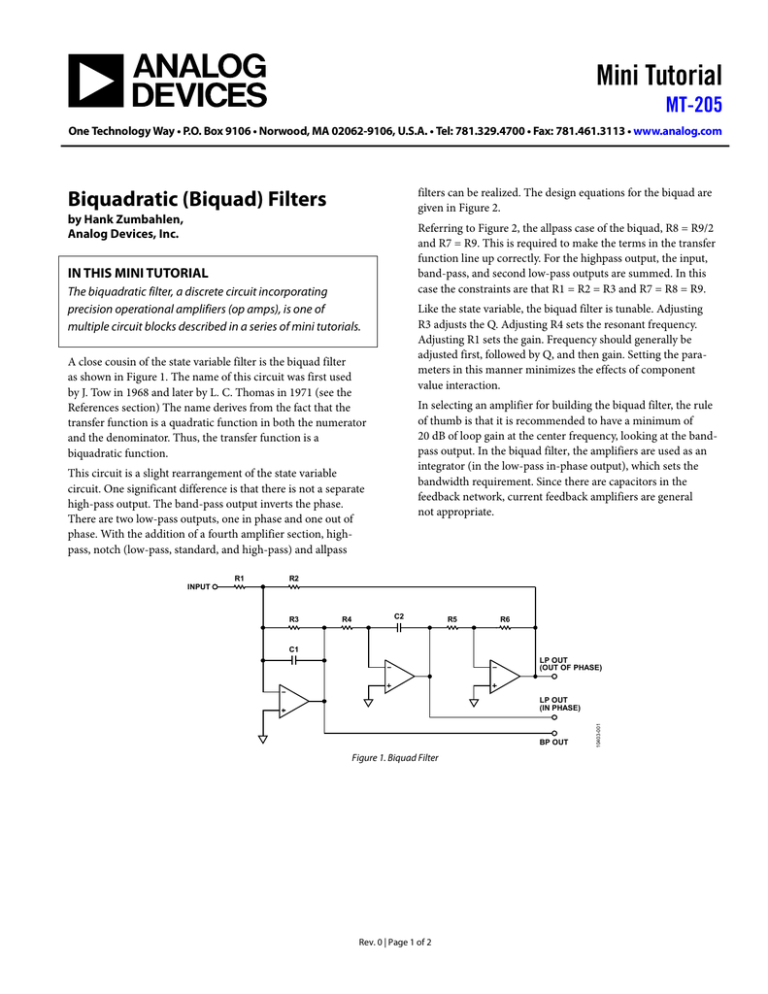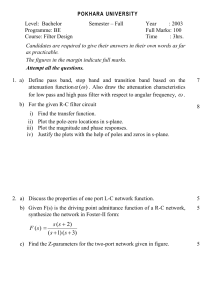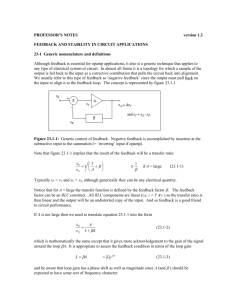Mini Tutorial MT-205
advertisement

Mini Tutorial MT-205 One Technology Way • P.O. Box 9106 • Norwood, MA 02062-9106, U.S.A. • Tel: 781.329.4700 • Fax: 781.461.3113 • www.analog.com filters can be realized. The design equations for the biquad are given in Figure 2. Biquadratic (Biquad) Filters by Hank Zumbahlen, Analog Devices, Inc. Referring to Figure 2, the allpass case of the biquad, R8 = R9/2 and R7 = R9. This is required to make the terms in the transfer function line up correctly. For the highpass output, the input, band-pass, and second low-pass outputs are summed. In this case the constraints are that R1 = R2 = R3 and R7 = R8 = R9. IN THIS MINI TUTORIAL The biquadratic filter, a discrete circuit incorporating precision operational amplifiers (op amps), is one of multiple circuit blocks described in a series of mini tutorials. Like the state variable, the biquad filter is tunable. Adjusting R3 adjusts the Q. Adjusting R4 sets the resonant frequency. Adjusting R1 sets the gain. Frequency should generally be adjusted first, followed by Q, and then gain. Setting the parameters in this manner minimizes the effects of component value interaction. A close cousin of the state variable filter is the biquad filter as shown in Figure 1. The name of this circuit was first used by J. Tow in 1968 and later by L. C. Thomas in 1971 (see the References section) The name derives from the fact that the transfer function is a quadratic function in both the numerator and the denominator. Thus, the transfer function is a biquadratic function. In selecting an amplifier for building the biquad filter, the rule of thumb is that it is recommended to have a minimum of 20 dB of loop gain at the center frequency, looking at the bandpass output. In the biquad filter, the amplifiers are used as an integrator (in the low-pass in-phase output), which sets the bandwidth requirement. Since there are capacitors in the feedback network, current feedback amplifiers are general not appropriate. This circuit is a slight rearrangement of the state variable circuit. One significant difference is that there is not a separate high-pass output. The band-pass output inverts the phase. There are two low-pass outputs, one in phase and one out of phase. With the addition of a fourth amplifier section, highpass, notch (low-pass, standard, and high-pass) and allpass R1 R2 INPUT R3 R4 C2 R5 R6 C1 LP OUT (OUT OF PHASE) BP OUT Figure 1. Biquad Filter Rev. 0 | Page 1 of 2 10403-001 LP OUT (IN PHASE) MT-205 Mini Tutorial BIQUADRATIC R1 R2 INPUT R3 R4 C2 R5 CHOOSE C, R2, R5 R6 K = 2πf0C C1 = C2 = C C1 R1 = R2 H R3 = 1 kα LP LP 1 R4 = 2 k R2 R5 = R6 BP HIGH PASS R7 R10 INPUT HP R8 BP R7 = R8 = R9 = R R R10 = H R9 LP2 NOTCH R7 R9 BP OUT NOTCH OUT H=1 R7 = R8 = R9 R8 INPUT ALL PASS R7 INPUT R9 AP OUT H=1 R7 = R9 R8 = R7/2 R8 10403-002 BP OUT Figure 2. Biquad Filter Design Equations REFERENCES J. Tow, "Active RC Filters–A State-Space Realization”, Proc. IEEE, 1968, Vol.56, pp. 1137-1139. L.C. Thomas, "The Biquad: Part I–Some Practical Design Considerations", IEEE Trans. Circuits and Systems, Vol. CAS-18, 1971, pp. 350-357. L.C. Thomas, "The Biquad: Part II–A Multipurpose Active Filtering System," IEEE Trans. Circuits and Systems, Vol. CAS-18, 1971, pp. 358-361. Zumbahlen, Hank. Linear Circuit Design Handbook. Elsevier. 2008. ISBN: 978-7506-8703-4. REVISION HISTORY 1/12—Revision 0: Initial Version ©2012 Analog Devices, Inc. All rights reserved. Trademarks and registered trademarks are the property of their respective owners. MT10403-0-1/12(0) Rev. 0 | Page 2 of 2








